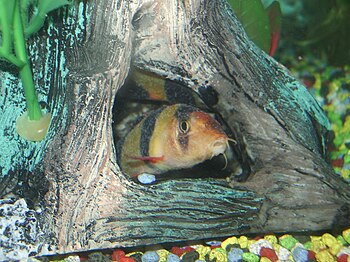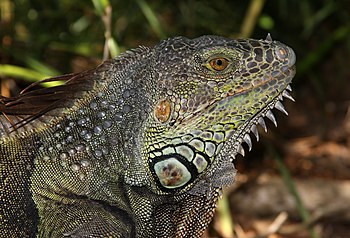The Penguin Tetra is actually two related species, Thayeria boehlkei and Thayeria obliqua. The easily seen differences between these species are quite small. Both species have a tendency to swim in a tail down position, but this is more pronounced in Thayeria obliqua. Thayeria obliqua has a shorter black line than Thayeria boehlkei, and Thayeria obliqua grows a little bigger although these are both small fish.
 |
| Penguin Tetra (Thayeria boehlkei) (Photo credit: Wikipedia) |
The species most often available in aquarium shops is Thayeria boehlkei. Some people prefer to keep the name Penguin Tetra for Thayeria obliqua and call Thayeria boehlkei the False Penguin Tetra. There are several other common names for this fish, some of them, like Penguinfish, Penguin Fish, etc are also based on its perceived resemblance to a penguin, while others like Short Striped Thayeria do not. In Australia, it is often sold as a Hockey Stick Tetra. Certainly the shape of the prominent black line is reminiscent of the shape of a hockey stick.
Thayeria boehlkei grows to about one and a half inches (4cm) long while Thayeria obliqua can get a little bit bigger. They come from the Amazon River and its tributaries in Brazil and Peru, preferring slow moving stretches with a lot of plants.
Water conditions
The Penguin Tetra is actually two related species, Thayeria boehlkei and Thayeria obliqua. The easily seen differences between these species are quite small. is a tropical fish. 24 degrees C (75 degrees F) is a suitable temperature to set your thermostat. The water they are used to in the wild is soft and acid, but in captivity they will adjust to neutral pH and some hardness. The penguin Tetra does better in clean water and care needs to be taken with the water quality. They are sensitive to Ammonia, Nitrite and excessive concentrations of Nitrate.
Food
Like many tetras, the Penguin Tetra is an easily fed omnivore. It will eat all normal aquarium foods, but will enjoy some live food like mosquito larvae and Daphnia. Frozen foods, including frozen blood worms are also appreciated.
Companions
The Penguin Tetra is a peaceful schooling fish. I suggest a minimum of four, and preferably more be kept together. They can be kept with most small, reasonable peaceful fish, including: Red Eye Tetras, Neon Tetras, Cardinal Tetras, Silvertip Tetras, Gold Barbs, Cherry Barbs, Pristella Tetras, Rummy Nose Tetras, Harlequin Rasboras, Scissortail Rasboras, Lemon Tetras, Emperor Tetras, Head and Tail Light Tetras, Glass Bloodfin Tetras, Swordtails, Platies, Mollies, Zebra Danios, Glowlight Tetras, White Cloud Mountain Minnows, Black Widow Tetras, Rosy Barbs, Tiger Barbs, Paraguay Tetras, Buenos Aires Tetras and Colombian Tetras, as well as the Corydoras catfish like the Peppered Catfish.
A school of Penguin Tetras can usually even be kept with slow long finned fish like Siamese Fighting Fish, Guppies and Endlers Guppies.
Sexing
There is not much difference between the sexes of the Penguin Tetra, but when in breeding condition, the females get a rounder belly.
Breeding
Thayeria boehlkei is the Penguin Tetra most likely to be available in shops and this fish is reasonably easy to breed. I suggest a water level lowered to about 6 inches (15cm) acidic and very soft water with a temperature of about 27 degrees C (81 degrees F). There should be fine leaved, bushy plants in the breeding tank.
The Penguin Tetra is a prolific breeder in the sense of producing a lot of eggs. A female of this little fish with a very well rounded belly can produce as many as 3000 eggs. These are very small. The male produces a large amount of sperm to try to fertilize all these eggs, and this can contribute to fouling the water. Partial water changes are recommended to maintain the high quality of water that the fry need. The addition of an aquarium fungicide is recommended to help protect the eggs from fungus early on. The eggs should hatch in as little as 12-18 hours. The babies are very small, and need protozoa (infusoria) at first.
Pest Fish
Although the Penguin Tetra is a delight in an aquarium, as with all pets, do not allow them to get into ecosystems they are not native to. Aquarist are frequently blamed for this, and there is no doubt that there are cases of accidental, or deliberate, release of fish by aquarists, but my own research suggests that the worst culprits for this historically have been governments and their departments.
By Steve Challis
Steve Challis has many other fish fact sheets and other articles on http://www.bettatrading.com.au.
Article Source: EzineArticles
|








